|
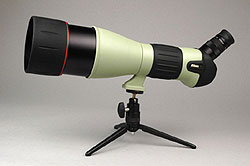
The 82Ed Fieldscope here seen with a sunshade in working position with a 20x – 45x zoom lens
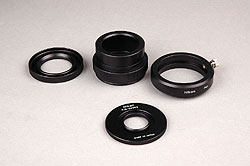
The FSA adaptor to fix digital compact cameras with an F/S-CP9XX adapting ring
for the Coolpix 9(XX) family, or like the Coolpix 4500
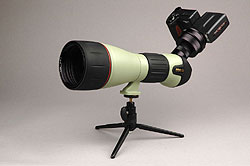
A 990 Coolpix mounted ready for work
|
 |
Introduction
In the history of human needs one of those most desired has been to be able to magnify distant objects.
Let's think of the film Robin Hood with Mel Gibson where Morgan Freeman gives him a primitive binocular made out of two lenses held together by a leather cylinder and Mel Gibson begins to wave his sword around seeing his enemies apparently so close; of Hitchcock's Window in the Courtyard where James Stuart uses the tele-eyepiece of his camera, not having a binocular, to first discover and then prevent the assassin's moves in the apartment opposite, or of Gattopardo by Visconti where Prince Salina´s studio was full of sparkling telescopes and binoculars. To move on to The Contact where a child Jodie Foster searches for her mother amongst the stars with a binocular, as well as many war films like The Battle of Midway, where the adversary American naval officers and the Japanese spend all day searching for each other through binoculars in the ocean's liquid plains.
It's exactly here that Nikon comes into the picture, precisely in 1917 when Admiral Mitsubishi of the imperial Japanese Navy created the company, Nippon Kogaku (literally translated ko=light, gaku= study, therefore "the study of light") to supply precision optical material for military use.
Therefore Nikon didn't start out as a photographic factory but as one of binoculars and telescopes.
Tens of years have passed by and we get to today: still today Nikon has as one of its strengths the production of terrestrial binoculars and telescopes.
The Models
|

|
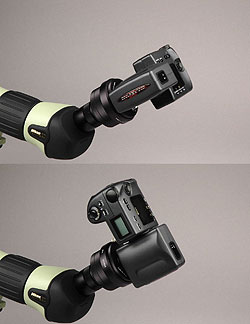
It's easy with a simple rotation of the two FSA adapter disks to change instantly form horizontal to vertical format
|
Nikon divides its production of telescopes between the Spottingscope and the Fieldscope. The first are for general use, telescopes that boast the best price/performance ratio; the second are the state of the art in optical vision by Nikon.
For this experience we have used the top of the Nikon range, The Fieldscope 82mm ED. Thanks to the front lens diameter of 82mm, this model boasts maximum light to pupil giving better vision during the day, at sunset and at night.
According to the interchangeable eyepiece that is fixed to the Fieldscope there can be from 20x to 70x magnifying; one can begin with a 20x lens, then to 30x and 38x (both WA) and also 50x, 50xWZ, 75x WA up to 20x-45x zoom lenses and 25x-75x.
Thanks to their interchangeability one can begin to work with a normal lens, like a 30x then later move on to zoom lens and/or a strong magnifying lens.
A general rule of thumb translates the lens used into the type of enlargement required, with a 75x lens the same enlargement as a 7,500mm is obtained but with incomparable quality of vision with respect to that reached using a mirror and even with the most noble reflex.
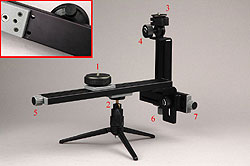 |
The UBK arm to fix any type of digital compact camera to the Fieldscope, also without threaded lens attachment: 1)Fieldscope 2) Tripod attachment 3) Spherical head with quick release attachment 4) Spherical head blocking arm 5) Fieldscope fine tuning screw 6,7) fine tuning screws for horizontal and vertical camera movements in the top left the Fieldscope attachment blocking screws with rotation marks |
|
|
|
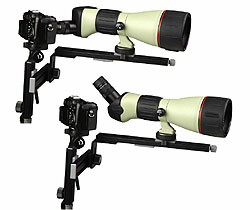 |
It's possible to rotate the Fieldscope pushing the release knob to go from direct vision to photographic shot |
|
|
|
 |
The FSA-L1 adapter to connect Nikon reflex digital and non digital cameras; on the right hand side the regulating screw is visible for the optical FSA-L1 adapter for all Fieldscope types and the screw to go from horizontal to vertical photographic format |
|
|
|
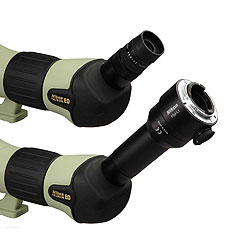 |
The FSA-L1 adapter fixes onto the Fieldscope instead of the lens. A wide threading range makes it an all-in-one with the Fieldscope |
|
|
|
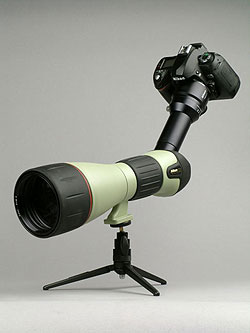 |
The Nikon D70 ready to shoot |







